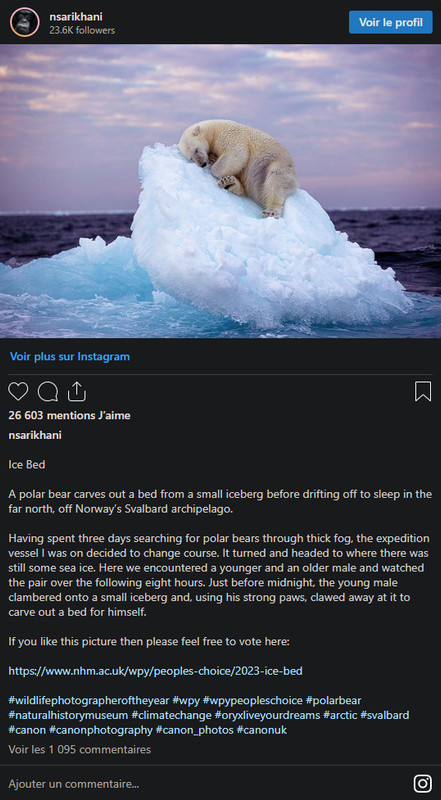"I hope that this photograph also inspires hope. There is still time to fix the mess we have caused."

Polar bears need sea ice to hunt and rest, but it's getting harder to find under the climate crisis.
Image credit: Nima Sarikhani/Wildlife Photographer Of The Year
An award-winning photograph of a polar bear’s unusual napping spot has captured global attention following the announcement of the Wildlife Photographer Of The Year People’s Choice Award. Ice Bed by Nima Sarikhani shows a polar bear that’s carved out a place to sleep from a small iceberg off Norway’s Svalbard archipelago, and it's really got people talking.
After receiving record-breaking support in the People’s Choice Award competition, it was announced as the winner with 75,000 votes. It was captured during a three-day search for polar bears through thick fog off Norway’s Svalbard archipelago aboard an expedition vessel. Just before midnight, the crew and its guests encountered a young male using its paws to carve out a bed on top of a small iceberg, before curling up to go to sleep.
Sea ice is a vital habitat for polar bears who need it to hunt, as well as rest, but in recent years there has been less and less of it to go around due to climate change. The image of the young polar bear making a bed on such a small spit of ice has understandably triggered a lot of emotion, demonstrating the plight of these animals.
“The period with sea ice over shallower water in much of the area is now much shorter than it was a few decades ago,” said Dr Jon Aars of the Norweigian Polar Bear Institute to London’s Natural History Museum. “While the bears that follow sea ice may still be able to hunt year-round, this is increasingly over deeper waters which may be less productive."
“The loss of sea ice also affects other aspects of their lifestyle. For example, the bears often no longer reach areas in the east that have traditionally been important for building dens. Instead, the bears are now often found hundreds of kilometres closer to the north pole, where the sea ice tends to be.”
Like other mammals, polar bear pups are reliant on their mother’s milk, but long journeys, reduced hunting opportunities, and denning difficulties can make it harder for them to carry babies to term and keep them alive after they’re born. The photo is therefore a stark reminder of what we stand to lose if action isn’t taken, but one that Sarikhani hopes can inspire positive change.

“I am so honoured to have won this year's People’s Choice award for WPY, the most prestigious wildlife photography competition,” Sarikhani said in a statement. “This photograph has stirred strong emotions in many of those who have seen it.”
“Whilst climate change is the biggest challenge we face, I hope that this photograph also inspires hope. There is still time to fix the mess we have caused.”
Wildlife Photographer of the Year is developed and produced by the Natural History Museum, London.
- franco46
-

 1
1




Recommended Comments
There are no comments to display.
Join the conversation
You can post now and register later. If you have an account, sign in now to post with your account.
Note: Your post will require moderator approval before it will be visible.